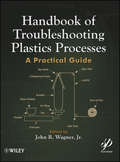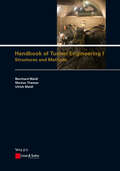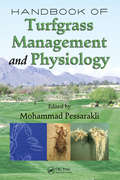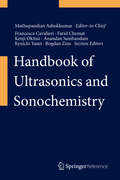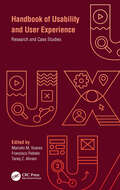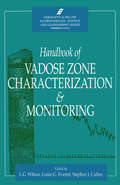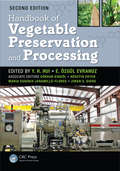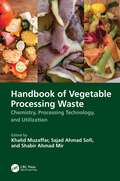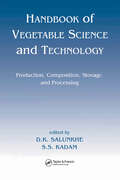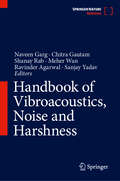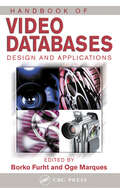- Table View
- List View
Handbook of Triboelectric Nanogenerators
by Zhong Lin Wang Jie Wang Ya Yang Junyi ZhaiThis handbook comprehensively covers the rapidly evolving field of power generation using triboelectric nanogenerators. Since their emergence in 2012, triboelectric nanogenerators have experienced fast development both in fundamental science aspects and technological innovations resulting in a plethora of outstanding applications and commercial opportunities in e.g. micro-nano energy systems, self-powered sensors, blue energy, and high-voltage power sources.The Handbook of Triboelectric Nanogenerators provides an indispensable overview of the state of the art in the field. It begins with a review of the physical and technological fundamentals and provides detailed coverage of triboelectric nanogenerators for cutting-edge applications from wearable electronics and medical implants to smart home sensing devices and human–machine interfacing.Edited and authored by active researchers in the field, the handbook offers a wealth of information for applied physicists and chemists, as well as materials scientists and engineers. In addition, mechanical and electronic engineers working in the fields of energy scavenging, power sources, and sensor-related application development will benefit greatly from the technical information presented in this groundbreaking reference work.
Handbook of Tropical Food Crops
by Franklin W. MartinFirst Published in 2018. Routledge is an imprint of Taylor & Francis, an Informa company.
Handbook of Tropical Residual Soils Engineering
by Arun Prasad David G. Toll Bujang B.K. HuatResidual soils are found in many parts of the world. Like other soils, they are used extensively in construction, either to build upon, or as construction material. They are formed when the rate of rock weathering is more rapid than transportation of the weathered particles by e.g., water, gravity and wind, which results in a large share of the soi
Handbook of Troubleshooting Plastics Processes
by John R. Wagner Jr.This handbook provides a framework for understanding how to characterize plastic manufacturing processes for use in troubleshooting problems. The 21 chapters are authored by well-known and experienced engineers who have specialized knowledge about the processes covered in this practical guide. From the Preface: "In every chapter, the process is described and the most common problems are discussed along with the root causes and potential technical solutions. Numerous case studies are provided that illustrate the troubleshooting process. Mark A. Spalding, The Dow Chemical Company
Handbook of Tunnel Engineering I: Structures and Methods, 1st Edition
by David S. Sturge Bernhard Maidl Ulrich Maidl Markus ThewesTunnel engineering is one of the oldest, most interesting but also challenging engineering disciplines and demands not only theoretical knowledge but also practical experience in geology, geomechanics, structural design, concrete construction, machine technology, construction process technology and construction management. The two-volume "Handbuch des Tunnel- und Stollenbaus" has been the standard reference for German-speaking tunnellers in theory and practice for 30 years. The new English edition is based on a revised and adapted version of the third German edition and reflects the latest state of knowledge. The book is published in two volumes, with the first being devoted to more practical themes of construction and construction process in drill and blast and mechanised tunnelling. Microtunnelling and ventilation are also dealt with. All chapters include practical examples.
Handbook of Tunnel Engineering II
by Bernhard Maidl Ulrich Maidl Markus ThewesTunnel engineering is one of the oldest, most interesting but also challenging engineering disciplines and demands not only theoretical knowledge but also practical experience in geology, geomechanics, structural design, concrete construction, machine technology, construction process technology and construction management. The two-volume "Handbuch des Tunnel- und Stollenbaus" has been the standard reference work for German-speaking tunnellers in theory and practice for 30 years. The new English edition is based on a revised and adapted version of the third German edition and reflects the latest state of knowledge. The book is published in two volumes, with the second volume covering both theoretical themes like design basics, geological engineering, structural design of tunnels and monitoring instrumentation, and also the practical side of work on the construction site such as dewatering, waterproofing and scheduling as well as questions of tendering, award and contracts, data management and process controlling. As with volume I, all chapters include practical examples.
Handbook of Turfgrass Management and Physiology
by Mohammad PessarakliA multibillion dollar industry that has tripled in the last ten years, turfgrass management plays an important role in landscaping, golf courses, and other sports surfaces. Proper management and cultural practices are crucial for the performance of these versatile grasses, creating a demand among scientists, researchers, and industry professionals
Handbook of Ultra-Wideband Short-Range Sensing
by Jürgen SachsRanging from the theoretical basis of UWB sensors via implementation issues to applications, this much-needed book bridges the gap between designers and appliers working in civil engineering, biotechnology, medical engineering, robotic, mechanical engineering, safety and homeland security.From the contents:* History* Signal and systems in time and frequency domain* Propagation of electromagnetic waves (in frequency and time domain)* UWB-Principles* UWB-antennas and applicators* Data processing* Applications
Handbook of Ultrasonics and Sonochemistry
by Muthupandian AshokkumarThe aim of this handbook is to summarize the recent development in the topic of ultrasonics and sonochemistry, especially in the areas of functional materials and processing applications. This handbook will benefit the readers as a full and quick technical reference with a high-level historic review of technology, detailed technical descriptions and the latest practical applications. This handbook is divided into five main sections: fundamentals of ultrasonics and sonochemistry, biomaterials, food processing, catalysts, wastewater remediation. Each section and chapter is written by reputable international scholars and industrial experts. The handbook comprehensively covers the fundamentals of sonochemistry along with key applications. The handbook strives to be a self-contained, easily-understandable reference that will also include up to date knowledge based on research articles. This handbook serves to provide a quick and reliable knowledge for new comers from chemistry, bioengineering, food processing, environmental engineering, in both academia and in industrial fields.
Handbook of Underground Gas Storages and Technology in China
by Xinhua MaThis book summarizes achievements and technology of China's underground gas storage in the past 20 years based on years of experience and technology accumulated in the construction and operation of gas storages. It also analyses and projects the future construction of underground gas storages in China Readers can systematically understand the construction status of China's underground gas storages, the difficulties encountered and the process and solution to such difficulties. It provides important theoretical and technical guidance for both in China and the world. Features of this book are listed as 1. Understand the development history, construction status, development trend of the underground gas storages around the world with countries and regions listed as case studies. 2. Understand the market demand of China's underground gas storages and resource distribution. 3. Understand the underground gas storages already built in China. 4. Understand the integrity management and risk control of the gas storages in China. 5. Understand the operation and management mode of gas storage. The target audience are those engaging in the research and technical management of the underground gas storage. It’s a valuable reference for both reseachers and college students as well in the fields of underground storage of carbon dioxide (CO2) and helium (He), Power to Gas energy accumulation.
Handbook of Unmanned Aerial Vehicles
by Kimon P. Valavanis George J. VachtsevanosThe Handbook of Unmanned Aerial Vehicles is a reference text for the academic and research communities, industry, manufacturers, users, practitioners, Federal Government, Federal and State Agencies, the private sector, as well as all organizations that are and will be using unmanned aircraft in a wide spectrum of applications. The Handbook covers all aspects of UAVs, from design to logistics and ethical issues. It is also targeting the young investigator, the future inventor and entrepreneur by providing an overview and detailed information of the state-of-the-art as well as useful new concepts that may lead to innovative research. The contents of the Handbook include material that addresses the needs and 'know how' of all of the above sectors targeting a very diverse audience. The Handbook offers a unique and comprehensive treatise of everything one needs to know about unmanned aircrafts, from conception to operation, from technologies to business activities, users, OEMs, reference sources, conferences, publications, professional societies, etc. It should serve as a Thesaurus, an indispensable part of the library for everyone involved in this area. For the first time, contributions by the world's top experts from academia, industry, government and the private sector, are brought together to provide unique perspectives on the current state-of-the-art in UAV, as well as future directions. The Handbook is intended for the expert/practitioner who seeks specific technical/business information, for the technically-oriented scientists and engineers, but also for the novice who wants to learn more about the status of UAV and UAV-related technologies. The Handbook is arranged in a user-friendly format, divided into main parts referring to: UAV Design Principles; UAV Fundamentals; UAV Sensors and Sensing Strategies; UAV Propulsion; UAV Control; UAV Communication Issues; UAV Architectures; UAV Health Management Issues; UAV Modeling, Simulation, Estimation and Identification; MAVs and Bio-Inspired UAVs; UAV Mission and Path Planning; UAV Autonomy; UAV Sense, Detect and Avoid Systems; Networked UAVs and UAV Swarms; UAV Integration into the National Airspace; UAV-Human Interfaces and Decision Support Systems; Human Factors and Training; UAV Logistics Support; UAV Applications; Social and Ethical Implications; The Future of UAVs. Each part is written by internationally renowned authors who are authorities in their respective fields. The contents of the Handbook supports its unique character as a thorough and comprehensive reference book directed to a diverse audience of technologists, businesses, users and potential users, managers and decision makers, novices and experts, who seek a holistic volume of information that is not only a technical treatise but also a source for answers to several questions on UAV manufacturers, users, major players in UAV research, costs, training required and logistics issues.
Handbook of Usability and User-Experience: Methods and Techniques
by Marcelo M. Soares, Francisco Rebelo and Tareq Z. AhramHandbook of Usability and User Experience: Methods and Techniques is concerned with emerging usability and user experience in design concepts, theories and applications of human factors knowledge focusing on the discovery, design and understanding of human interaction and usability issues with products and systems for their improvement. This volume presents methods and techniques to design products, systems and environments with good usability, accessibility and user satisfaction. It introduces the concepts of usability and its association with user experience, and discusses methods and models for usability and UX. It also introduces relevant cognitive, cultural, social and experiential individual differences, which are essential for understanding, measuring and utilizing these differences in the study of usability and interaction design. In addition, the book discusses the use of usability assessment to improve healthcare, the relationship between usability and user experience in the built environment, the state-of-the-art review of usability and UX in the digital world, usability and UX in the current context, and emerging technologies. We hope that this first of two volumes will be helpful to a large number of professionals, students and practitioners who strive to incorporate usability and user experience principles and knowledge in a variety of applications. We trust that the knowledge presented in this volume will ultimately lead to an increased appreciation of the benefits of usability and incorporate the principles of usability and user experience knowledge to improve the quality, effectiveness and efficiency of consumer products, systems and environments in which we live.
Handbook of Usability and User-Experience: Research and Case Studies
by Marcelo M. Soares, Francisco Rebelo and Tareq Z. AhramThis volume of the Handbook of Usability and User Experience (UX) presents research and case studies used to design products, systems and environments with good usability and consequent acceptance, pleasure in use, good user experience, and understanding of human interaction issues with products and systems for their improvement. The book presents concepts and perspectives of UX; it also discusses methods and tools that use requirements analysis activity elicitation, recording, and analysis to guarantee a good user experience. In addition, it introduces usability and UX in the automotive industry, usability and UX in a digital interface, game design and digital media, usability and UX in fashion design, and some case studies on usability and UX in various contexts in product design. We hope that this second volume will be helpful to a larger number of professionals, students and practitioners who strive to incorporate usability and UX principles and knowledge in a variety of applications. We trust that the knowledge presented in this volume will ultimately lead to an increased appreciation of the benefits of usability and incorporate the principles of usability and UX knowledge to improve the quality, effectiveness, and efficiency of everyday consumer products, systems, and environments.
Handbook of Vacuum Technology
by C. Benjamin Nakhosteen Karl JoustenThis comprehensive, standard work has been updated to remain an important resource for all those needing detailed knowledge of the theory and applications of vacuum technology. The text covers the existing knowledge on all aspects of vacuum science and technology, ranging from fundamentals to components and operating systems. It features many numerical examples and illustrations to help visualize the theoretical issues, while the chapters are carefully cross-linked and coherent symbols and notations are used throughout the book. The whole is rounded off by a user-friendly appendix of conversion tables, mathematical tools, material related data, overviews of processes and techniques, equipment-related data, national and international standards, guidelines, and much more. As a result, engineers, technicians, and scientists will be able to develop and work successfully with the equipment and environment found in a vacuum.
Handbook of Vadose Zone Characterization & Monitoring
by Lorne G. Everett L. Gray Wilson Stephen J. CullenThis book is written in a simple, straightforward manner without complicated mathematical derivatives. Compiled by experienced practitioners, this guide covers topics such as basic principles of vadose zone hydrology and prevalent monitoring techniques. Case studies present actual field experiences for the benefit of the reader. The Handbook provides practitioners with the information they need to fully understand the principles, advantages, and limitations of the monitoring techniques that are available.The Handbook of Vadose Zone Characterization & Monitoring expands and consolidates the useful and succint information contained in various ASTM documents, EPA manuals, and other similar texts on the subject, making it an invaluable aid to new practioners and a useful reference for seasoned veterans in the field.
Handbook of Vanilla Science and Technology
by Daphna Havkin-Frenkel Faith C. BelangerAn updated guide to the production, science, and uses of vanilla Vanilla is a flavor and fragrance in foods, cosmetics, pharmaceuticals, and a wealth of other products. Now in its second edition, the Handbook of Vanilla Science and Technology provides a comprehensive and updated review of the science and technology used in these items’ production and supply. Featuring contributions from an international range of experts, this revised edition covers a multitude of topics, including agricultural production, global markets, analytical methods, sensory analysis, food and fragrance applications, organic farming and fair trade, botanical diseases, and novel uses. The Handbook of Vanilla Science and Technology, Second Edition is a vital resource for producers, distributors, and scientists involved in vanilla’s growth and utilization, and offers readers: A guide to the cultivation, extraction, analysis, DNA sequencing, and marketing of vanilla Information on the production of vanilla in a range of countries such as Mexico, Australia, Costa Rica, and India Guidelines on the quality control of vanilla beans and extracts Information on fair trade and the future of vanilla
Handbook of Vanilla Science and Technology
by Daphna Havkin-Frenkel Faith C. BelangerVanilla is the world's most commonly-used flavour and fragrance, used in foods, cosmetics, pharmaceuticals and other products and is therefore of considerable economic importance. This book provides a comprehensive overview of the science and technology used in the production and supply chain of vanilla products. A wide range of international authors cover topics which include agricultural production, global markets, analytical methods, sensory analysis, food and fragrance applications, organic and fair trade vanilla, diseases that affect vanilla, and novel uses. It is of interest to academic researchers in this field and is also an important resource for the vanilla industry and those companies that use vanilla and vanillin as flavours and fragrances worldwide. Key Features: The only book to cover such a wide range of topics on this most commercially valuable of flavour ingredients Includes an analysis of the current vanilla markets in the US and Europe Edited by experts who hold roles in the flavour industry and academic research
Handbook of Vegetable Preservation and Processing (Food Science and Technology)
by Y. H. HUI • E. ÖZGÜL EVRANUZThe second edition of a bestseller, Handbook of Vegetable Preservation and Processing compiles the latest developments and advances in the science and technology of processing and preservation of vegetables and vegetable products. It includes coverage of topics not found in similar books, such as nutritive and bioactive compounds of vegetables; veg
Handbook of Vegetable Processing Waste: Chemistry, Processing Technology, and Utilization
by Shabir Ahmad Mir Khalid Muzaffar Sajad Ahmad SofiHandbook of Vegetable Processing Waste: Chemistry, Processing Technology, and Utilization serves as an essential resource for food scientists, environmental engineers, and industry professionals. This comprehensive book explores innovative and sustainable approaches in managing vegetable processing waste and transforming it into valuable resources. The book addresses chemistry, processing technology, and valorization of residues generated during vegetable processing. It provides an overview of the recovery of bioactive components from the vegetable processing waste and their utilization in the development of functional food.Key features: Provides comprehensive information about the chemistry of waste generated during vegetable processing Provides in-depth information about the bioactive and nutraceutical potential of residues obtained during processing of vegetables Provides insight into technologies which can be used for extraction of biofunctional compounds from vegetable-based processing waste Highlights valorization of vegetable processing waste in fabrication of novel functional foods
Handbook of Vegetable Science and Technology: Production, Compostion, Storage, and Processing
by D. K. Salunkhe S. S. Kadam"Furnishes exhaustive, single-source coverage of the production and postharvest technology of more than 70 major and minor vegetables grown in tropical, subtropical, and temperate regions throughout the world. Provides comparative data for each vegetable presented. "
Handbook of Vegetables and Vegetable Processing
by Muhammad Siddiq Mark A. UebersaxHandbook of Vegetables and Vegetable Processing, Second Edition is the most comprehensive guide on vegetable technology for processors, producers, and users of vegetables in food manufacturing.This complete handbook contains 42 chapters across two volumes, contributed by field experts from across the world. It provides contemporary information that brings together current knowledge and practices in the value-chain of vegetables from production through consumption. The book is unique in the sense that it includes coverage of production and postharvest technologies, innovative processing technologies, packaging, and quality management. Handbook of Vegetables and Vegetable Processing, Second Edition covers recent developments in the areas of vegetable breeding and production, postharvest physiology and storage, packaging and shelf life extension, and traditional and novel processing technologies (high-pressure processing, pulse-electric field, membrane separation, and ohmic heating). It also offers in-depth coverage of processing, packaging, and the nutritional quality of vegetables as well as information on a broader spectrum of vegetable production and processing science and technology. Coverage includes biology and classification, physiology, biochemistry, flavor and sensory properties, microbial safety and HACCP principles, nutrient and bioactive properties In-depth descriptions of key processes including, minimal processing, freezing, pasteurization and aseptic processing, fermentation, drying, packaging, and application of new technologies Entire chapters devoted to important aspects of over 20 major commercial vegetables including avocado, table olives, and textured vegetable proteins This important book will appeal to anyone studying or involved in food technology, food science, food packaging, applied nutrition, biosystems and agricultural engineering, biotechnology, horticulture, food biochemistry, plant biology, and postharvest physiology.
Handbook of Vegetables and Vegetable Processing (Food Science And Technology Ser.)
by E. Özgül Evranuz Jasim Ahmed Muhammad Siddiq Nirmal Sinha Y. H. HuiVegetables are an important article of commerce both in developed and developing economies. Many studies point to importance of vegetables in our diet. Handbook of Vegetables and Vegetable Processing serves as a reference handbook on vegetables and vegetable processing containing the latest developments and advances in this fast growing field. The book can be considered as a companion to Y. H. Hui’s popular Handbook of Fruits and Fruit Processing (2006). Handbook of Vegetables and Vegetable Processing is contemporary in scope, with in-depth coverage of new interdisciplinary developments and practices in the field of vegetables emphasizing processing, preservation, packaging, and nutrition and food safety. Coverage includes chapters on the biology, horticultural biochemistry, microbiology, nutrient and bioactive properties of vegetables and their significant commercialization by the food industry worldwide. Full chapters are devoted to major vegetables describing aspects ranging from chemistry to processing and preservation. World-renowned editors and authors have contributed to this essential handbook on vegetables and their production, technology, storage, processing, packaging, safety and commercial product development. Special Features: Coverage includes biology and classification, physiology, biochemistry, flavor and sensory properties, microbial safety and HACCP principles, nutrient and bioactive properties In-depth descriptions of key processes including, minimal processing, freezing, pasteurization and aseptic processing, fermentation, drying, packaging, and application of new technologies Entire chapters devoted to important aspects of over 20 major commercial vegetables including avocado, table olives and textured vegetable proteins Unparalleled expertise on important topics from more than 50 respected authors
Handbook of Vibroacoustics, Noise and Harshness
by Sanjay Yadav Naveen Garg Meher Wan Shanay Rab Chitra Gautam Ravinder AgarwalThe handbook covers the topics of vibro-acoustics, noise, harshness and their related applications in detail. Various topics covered in this handbook are acoustics and vibration metrology, environmental noise measurements, building acoustics, acoustical meta-materials, underwater acoustics, soundscape approach, beam forming approach, 3D noise mapping, in-situ acoustical testing, etc. The handbook would provide a single window source of up-to-date information to the researchers, acousticians, noise and vibration control engineers, metrologists, industry, university graduates, masters, academicians, administrators, policymakers, regulators, and other stakeholders for a better understanding of vibro-acoustics, noise, harshness and related applications.
Handbook of Video Databases: Design and Applications (Internet and Communications)
by Borko Furht Oge MarquesTechnology has spurred the growth of huge image and video libraries, many growing into the hundreds of terabytes. As a result there is a great demand among organizations for the design of databases that can effectively support the storage, search, retrieval, and transmission of video data. Engineers and researchers in the field demand a comprehensi
Handbook of Vinyl Polymers: Radical Polymerization, Process, and Technology, Second Edition
by Yusuf Yagci Munmaya K. MishraRadical polymerization is one of the most widely used means of producing vinyl polymers, supporting a myriad of commercial uses. Maintaining the quality of the critically acclaimed first edition, the Handbook of Vinyl Polymers: Radical Polymerization, Process, and Technology, Second Edition provides a fully updated, single-volume source on t



